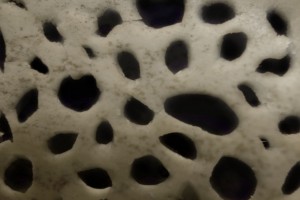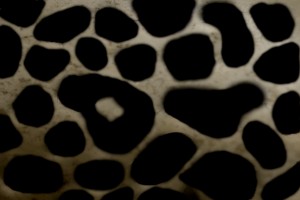Bone Density Testing
What is Osteoporosis?
Osteoporosis literally means ‘Porous Bones’. It occurs when the rate of
bone renewal does not match the rate of breakdown, eventually resulting
in weak, brittle bones. Sufferers generally do not realise they have the
condition until they break a bone, by which time it is too late for them to
take the most effective action. Often, the condition is a result of a
lifetime’s failure to take preventative measures: Osteoporosis has been
referred to as a ‘Pediatric disease with geriatric consequences.’
Normal Bone

Osteoporotic Bone

Facts and figures
The incidence of osteoporosis has almost doubled in the last 30 years. In
Britain more than 500,000 received treatment for fragility fractures every
year as a result of osteoporosis, costing an estimated
£4.4 billion to the NHS
.
This has surpassed the 1994 prediction that by 2020 the cost would have
been 2.1 billion. It seems that we are far from getting to grips with this
condition. This is without the indirect costs, such as pain, time off work,
lost productivity, and the untold social effect on the families of patients.
Estimates vary, however it has been stated that after the age of 50, 1 in
2-3 women, and 1 in 5-12 men in the UK will sustain a fracture, in the
main due to osteoporosis. In fact, more women die each year from
osteoporosis than die from cancer of the ovaries, uterus and cervix
combined. This is a frightening and unnecessary statistic for a condition
that is both preventable and treatable.
The World Health Organisation suggests that health promotion and
preventative measures are crucial for containing the effects of
osteoporosis on the world population
Hip fracture
Of all of the fractures that occur as a result of osteoporosis, hip fracture is
the most serious. Hip fractures alone account for 69000
emergency admissions
into English hospitals, adding up to 1.3 million bed days and a cost of £1.5 billion each year.
That is only the hospital costs! Once you add in the combined cost of hospital
and social care for patients with a hip fracture the cost is well over £2
billion per year in the UK. Depending upon the estimate, white,
postmenopausal women have a one in six or one in seven risk of
sustaining a hip fracture in their lifetime. This is higher than the risk of
developing breast cancer. Out of four women that suffer this type of
fracture, only one will ever recover completely; the rest will suffer
permanent disability.
Typically one in four will die within a year. The worst
news, though, is that 80% of older women would rather die than
experience the pain, disability, and reduced quality of life that follows
from a serious hip fracture and subsequent admission into a nursing home.
Combat Osteoporosis – it is preventable and treatable!
It is often difficult to get a bone density scan or treatment for
osteoporosis, even if you have already had a fragility fracture(!) and it can
be expensive to pay for a private appointment. I can offer you the chance
to have your bone density checked, either by participating in – or hosting
– a bone density awareness and testing day. I offer a heel quantitative
ultrasound scan (or QUS), which has been shown to be a reliable indicator
of bone density and fracture risk in particular, of hip fracture risk.
QUS is comparatively reasonably priced, and free from radiation, as it uses sound
waves rather than X rays to measure bone density. This type of test has
been recommended as a ‘first step’ to educate yourself about your bone
health and safeguard yourself against osteoporosis. Find out more about
the type of test I offer.
Take Action!
If you have a bone density test with me, I will take the time to explain
exactly what your results mean to you. I’ll also give you two sets of copies
of your results – one to keep, and one to give to your GP. From my
perspective, one of the most important things about having a test is that
screening bone density and explaining the results of the scan to the individual has been shown to be a
motivator of osteoporosis preventive behaviour.
In other words, after having a scan with me you will be much more likely to go out and actually act upon the advice that I give – much more than if I just gave you the advice on its own or,
forexample, handed out leaflets at a stall or stand. From the results of this
In other words, after having a scan with me you will be much more likely to go out and actually act upon the advice that I give – much more than if I just gave you the advice on its own or,
forexample, handed out leaflets at a stall or stand. From the results of this
test, and the information and advice I give out, you, and your colleagues,
employees, members or even friends will be better educated and
motivated to help combat this illness,
giving you all agreater chance of maintaining your bone density in later life.
giving you all agreater chance of maintaining your bone density in later life.
